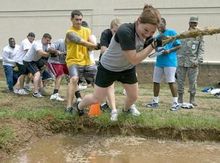| Excerpt from www.NDMA.COM, © 2026 N. Dean Meyer and Associates Inc.
Executive Summary: How to Induce High-performance Cross-boundary Teamwork
You can't specialize if you can't team! Here's how to build highly effective, dynamic processes of cross-boundary teamwork (workflows).
by N. Dean Meyer
One common approach to improving teamwork is "teambuilding." It assumes that teamwork fails for lack of interpersonal relationships or trust.

Another common approach to cross-boundary teamwork is "process engineering," where a sequence of tasks is mapped and assigned to groups. This has numerous problems:
Another approach is metrics of the team's performance (rather than individual performance). But shared accountabilities are no accountabilities. This just leads to finger-pointing, without clarity about who is in control of (and hence accountable) for what. A closely related approach is metrics of people's ability to team. This is an ineffective patch for a deeper problem. Something is misaligned. Consider: Why is it that serving teams isn't in the best interests of individuals? (If it were, you wouldn't have to incentivize teamwork; individual performance metrics would drive people to team well.) Installing one incentive to overcome another opposing incentive doesn't lead to optimal or predictable outcomes. And at best, it masks the more fundamental root causes of poor teamwork. A more powerful approach is based on the business-within-a-business paradigm.
Think of each group as an independent business within a business, selling products and services to peers within the organization as well as to clients. Each project is assigned to the group that "sells" that product (whether or not money changes hands). That group is considered the "prime contractor," akin to a general contract who builds houses. Like in the real world, the first job of a prime contractor is to line up any needed "subcontractors," that is, to arrange for help from peers. Subcontractors may, in turn, "buy" results from other groups in the organization. In this way, teams form spontaneously across boundaries. Teams include just the right people at just the right time. And individual accountabilities for results are clear, as is the chain of command within each team.
This is a "meta-process" -- a process for determining processes in the context of specific projects or services. That means that teamwork processes are adapted to fit the needs of each unique project, without any loss of clarity. This approach builds great cross-boundary teamwork without depending on individual's personal relationships (fragile, since people change jobs), and without making an organization a slave to rigid pre-defined processes. What can you do to implement this dynamic approach to teamwork? Consider a brief series of leadership-team workshops to define your organization's operating model (who sells what to whom).
|

